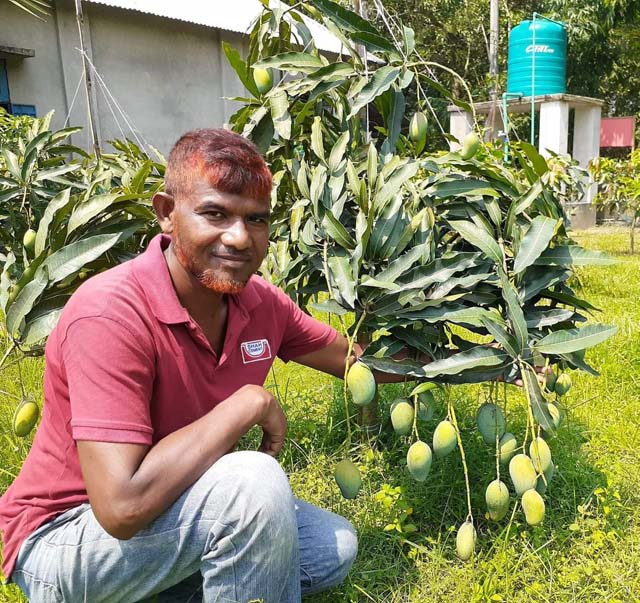
By Md Aynal Haque
RAJSHAHI, July 5, 2024 (BSS) - Ultra High Density Mango Plantation (UHDMP) method has become boons for farmers as it doubles yield in the Barind area, appearing to be water-stressed day by day due to the adverse impact of climate change.
According to the farmers and officials concerned, the UHDMP method has gained popularity as the growers are getting additional profit using the system in Rajshahi region, including its vast Barind tract.
Besides, the modern farming system has brought a new dimension to the local economy by diversifying the cropping pattern here, they said.
Ziarul Islam, 38, has become a promising farmer in his Chabbishnagar village of Godagari upazila as he has earned around Taka 1.35 lakh after selling mangoes of 160 trees last year.
He said the UHDM orchards are contributing a lot towards extra income giving better life to the beneficiary family members. Hefaz Uddin, 64, a resident of Bailkapara village of Nachole Upazila in Chapainawabganj, has got double benefit adopting the method.
In 2018, he planted 100 trees of BARI-4 mango variety on his one acre of land using this UHDMP method as he got technical support from a project titled "Climate Resilient Agricultural Advancement in Barind".
It's being implemented in Paba upazila of Rajshahi, Sadar of Chapainawabganj and Niamotpur and Potnitola upazilas in Naogaon districts.
Rafikul Islam, 50, another farmer of Enayetpur village in Mohadevpur Upazila of Naogaon district, developed UHDM orchard consisting of 130 trees of Amrapali, 40 of BARI-4 and five of Banana mango on 25 decimal of land in 2019.
Subsequently, he nourished the orchard as recommended by the officials concerned during the last four years.
In 2023, he pocketed Tk 70,000 by selling mangoes from his 130 plants.DASCOH Foundation has been implementing the project technically supported by the Syngenta Foundation and financially supported by the Hongkong and Shanghai Banking Corporation Limited.
The project is expected to benefit 25,000 farmers by climate-smart agriculture practices with achieving significant production in a sustainable manner by introducing efficient irrigation and other relevant technologies and management practices.
Hefaz Uddin got yield from 84 trees in 2021, fetching Taka 51,120. "I had harvested 6.7 kilograms of yield from each of the trees on an average," he said with a smiling face, while talking to BSS on Thursday.
He expected more income from his land with the application of new agricultural technology, saying the method draws additional income by doubling the yield, contributing to the living standard of the local people.
Like Hefez Uddin, many other farmers have attained economic emancipation after adopting the UHDMP method that has brought a remarkable change in mango plantation in the region.
Akramul Haque, Chief Executive Officer of DASCOH Foundation, said local agro-business opportunities will be expanded through a strong public-private stakeholder network.
He said the new mango orchards, especially of Amrapali, BARI mango-3 and 4 varieties are rapidly increasing in the districts every year.
While the traditional larger trees take eight to nine years to bear fruit, the UHDMP method's smaller trees produce fruit within two or three years, he said.
The smaller varieties are gaining popularity as more trees can be planted on the same piece of land and their harvest time is shorter, he added.
Normally 10 mango trees are planted in one bigha of land, but in the new farming method, farmers can plant up to 200 trees in the same space, Haque said.
A silent revolution has happened in both farming and yield of mango in the region, vibrating the local economy during the last couple of years as witnessing the success, many people, particularly the grassroots farmers and entrepreneurs, are adopting the UHDMP and making profit, he said.
This method can enhance agro-water productivity along with reducing groundwater extraction and increasing farmers' income in the water-stressed Barind area.
Farhad Zamil, country director of Syngenta Foundation, mentioned that the critical components of UHDMP technology are the management of inputs related to irrigation and fertilizer and the canopy management.
These two inputs are provided through drip irrigation systems.
Pruning is a very essential and critical operation of UHDMP to maintain fruiting shoots and to contain its canopy.
It must be done soon after harvest, preferably before 15 June. Zamil said: "About a month after pruning, thinning of the newly emerged shoots is essential in order to avoid excess ones and overcrowding.
He said it increases productivity up to 2-3 times, reduces water used for irrigation up to 50 per cent and increases fertiliser intake by plants.